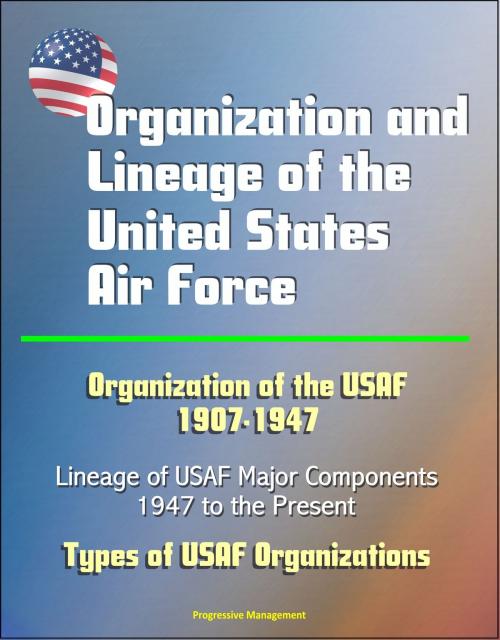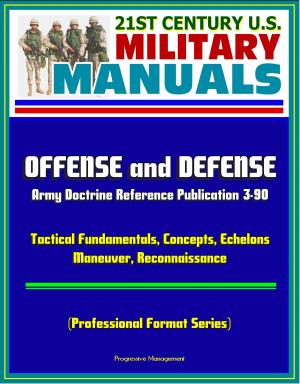Organization and Lineage of the United States Air Force: Organization of the USAF 1907-1947, Lineage of USAF Major Components, 1947 to the Present, Types of USAF Organizations
Nonfiction, History, Military, Aviation| Author: | Progressive Management | ISBN: | 9781311749598 |
| Publisher: | Progressive Management | Publication: | September 22, 2014 |
| Imprint: | Smashwords Edition | Language: | English |
| Author: | Progressive Management |
| ISBN: | 9781311749598 |
| Publisher: | Progressive Management |
| Publication: | September 22, 2014 |
| Imprint: | Smashwords Edition |
| Language: | English |
This fascinating report surveys the evolution of the Air Force field structure from the earliest military aeronautical organizations to those comprising the modern Air Force. It does not examine every organizational facet of the Army Air Service, Army Air Corps, Army Air Forces, or United States Air Force, but it does trace most of the major organizations. It is intended to describe how the Air Force came to be, how it evolved organizationally, and how it was organized to accomplish its defense mission.
The work consists of three parts. The first part surveys the beginning of the United States Army's air arm, birth of the Air Service, principal organizations created between the world wars, tremendous organizational growth during World War II, and the changes that occurred in the immediate postwar period. Part two, perhaps of most interest to Air Force personnel, discusses the superstructure of the service—the commands, separate operating agencies, direct reporting units, and numbered and named air forces. The lineages of these upper echelon establishments are traced from their creation to 1983. The final part examines the current USAF organizational hierarchy, from major commands down to functional entities, including detachments and operating locations.
Heraldic illustrations in this volume are current through 1983. Only organizations with officially recognized emblems are represented. The U.S. Air Force Historical Research Center is responsible for all Air Force heraldry and now retains the original paintings of these emblems as an authoritative record. Colors shown in the emblems are reproduced as faithfully as the printing process will allow.
All Air Force organizations are planned entities, many having lengthy lives under a variety of names. To avoid confusing one organization with another, the Air Force employs an identification system known as lineage. Although an organization that exists today may have begun its existence with a different name or a different number, or both, and may have existed for one or more periods only on paper, it can be identified as the same organization through its lineage. Tracing unit lineage involves determining all of the organizational actions which have affected an organization throughout its existence—actions such as constitution, reconstitution, disbandment, inactivation, activation, and redesignation.
All units regardless of category must be readily identifiable; thus, each one has a distinctive designation. The designation includes a generic name (for example, squadron) denoting its position in the hierarchy, a functional name (for example, Bombardment) describing its primary mission, and in most cases a numerical or geographical name (examples, 9th, as in "9th Bombardment Squadron," or Craig, as in "USAF Hospital, Craig") that distinguishes it from all other units having the same functional and generic names. Without such distinctive designations, the lineage of Air Force organizations would be almost impossible to determine.
This fascinating report surveys the evolution of the Air Force field structure from the earliest military aeronautical organizations to those comprising the modern Air Force. It does not examine every organizational facet of the Army Air Service, Army Air Corps, Army Air Forces, or United States Air Force, but it does trace most of the major organizations. It is intended to describe how the Air Force came to be, how it evolved organizationally, and how it was organized to accomplish its defense mission.
The work consists of three parts. The first part surveys the beginning of the United States Army's air arm, birth of the Air Service, principal organizations created between the world wars, tremendous organizational growth during World War II, and the changes that occurred in the immediate postwar period. Part two, perhaps of most interest to Air Force personnel, discusses the superstructure of the service—the commands, separate operating agencies, direct reporting units, and numbered and named air forces. The lineages of these upper echelon establishments are traced from their creation to 1983. The final part examines the current USAF organizational hierarchy, from major commands down to functional entities, including detachments and operating locations.
Heraldic illustrations in this volume are current through 1983. Only organizations with officially recognized emblems are represented. The U.S. Air Force Historical Research Center is responsible for all Air Force heraldry and now retains the original paintings of these emblems as an authoritative record. Colors shown in the emblems are reproduced as faithfully as the printing process will allow.
All Air Force organizations are planned entities, many having lengthy lives under a variety of names. To avoid confusing one organization with another, the Air Force employs an identification system known as lineage. Although an organization that exists today may have begun its existence with a different name or a different number, or both, and may have existed for one or more periods only on paper, it can be identified as the same organization through its lineage. Tracing unit lineage involves determining all of the organizational actions which have affected an organization throughout its existence—actions such as constitution, reconstitution, disbandment, inactivation, activation, and redesignation.
All units regardless of category must be readily identifiable; thus, each one has a distinctive designation. The designation includes a generic name (for example, squadron) denoting its position in the hierarchy, a functional name (for example, Bombardment) describing its primary mission, and in most cases a numerical or geographical name (examples, 9th, as in "9th Bombardment Squadron," or Craig, as in "USAF Hospital, Craig") that distinguishes it from all other units having the same functional and generic names. Without such distinctive designations, the lineage of Air Force organizations would be almost impossible to determine.















